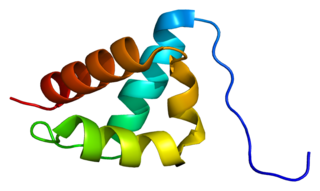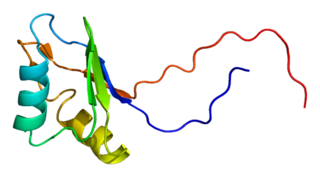| Wbp11 | |||||||||
|---|---|---|---|---|---|---|---|---|---|
| Identifiers | |||||||||
| Symbol | Wbp11 | ||||||||
| Pfam | PF09429 | ||||||||
| InterPro | IPR019007 | ||||||||
| |||||||||
| Wbp11 | |||||||||
|---|---|---|---|---|---|---|---|---|---|
| Identifiers | |||||||||
| Symbol | Wbp11 | ||||||||
| Pfam | PF09429 | ||||||||
| InterPro | IPR019007 | ||||||||
| |||||||||
Studies suggest that Wbp11 plays a role in DNA/ RNA transcriptional or post-transcriptional events related to cell division. [5] Wbp11 is found in the nucleus but not the nucleoli of cells in interphase. However it is distributed throughout the cytoplasm in dividing cells. [6] Immunoelectron-microscopy experiments suggest that relocation from a peri-nuclear to a cytoplasmic distribution, coinciding with the onset of mitosis in cell division. Other studies have shown that Wbp11 is a component of the spliceosome. Also, that Wbp11 fragments block pre-mRNA splicing catalysis. [7]
Wbp11 is a polypeptide known to interact with other WW domain of proteins such as the nuclear protein Npw38 via two proline-rich regions. It associates with Npw38 (hence the name NpwBP) in the nuclei and with Poly(rG) and G-rich ssDNA. [5] The 70kDa protein has also been found to interact with SH3 (Src homology domain 3) domains. The C-terminal proline-rich sequences of SNP70/NpwBP/Wbp11, which binds to the WW domain of Npw38 also fits with both classic type I and type II SH3 binding sequences, hence the name (SNP70).
Wbp11 was found to bind strongly to the tandem SH3 domains of p47phox and to the N-terminal SH3 domain of p47phox, and more weakly to the SH3 domains from c-src and p85α. p47phox. [6]
Furthermore, it has been shown to interact with PP1(protein phosphotase 1), hence the name SIPP1. It has an inhibitory effect to PP1, with its inhibitory potency increasing upon phosphorylation with protein kinase CK1. The binding of Wbp11 with PP1 involves a RVXF (Arg-Val-Xaa-Phe) motif, which functions as a PP1- binding sequence in most interactors of PP1. [7]
A number of other interactions have been indicated such as:

KH domain-containing, RNA-binding, signal transduction-associated protein 1 is a protein that in humans is encoded by the KHDRBS1 gene.

Heterogeneous nuclear ribonucleoprotein K is a protein that in humans is encoded by the HNRNPK gene. It is found in the cell nucleus that binds to pre-messenger RNA (mRNA) as a component of heterogeneous ribonucleoprotein particles. The simian homolog is known as protein H16. Both proteins bind to single-stranded DNA as well as to RNA and can stimulate the activity of RNA polymerase II, the protein responsible for most gene transcription. The relative affinities of the proteins for DNA and RNA vary with solution conditions and are inversely correlated, so that conditions promoting strong DNA binding result in weak RNA binding.

Neutrophil cytosol factor 1, also known as p47phox, is a protein that in humans is encoded by the NCF1 gene.

Filamin A, alpha (FLNA) is a protein that in humans is encoded by the FLNA gene.

Y box binding protein 1 also known as Y-box transcription factor or nuclease-sensitive element-binding protein 1 is a protein that in humans is encoded by the YBX1 gene.

Transcription factor PU.1 is a protein that in humans is encoded by the SPI1 gene.

Neutrophil cytosol factor 4 is a protein that in humans is encoded by the NCF4 gene.

Splicing factor, proline- and glutamine-rich is a protein that in humans is encoded by the SFPQ gene.

Apoptosis-stimulating of p53 protein 2 (ASPP2) also known as Bcl2-binding protein (Bbp) and tumor suppressor p53-binding protein 2 (p53BP2) is a protein that in humans is encoded by the TP53BP2 gene. Multiple transcript variants encoding different isoforms have been found for this gene.

Splicing factor 3 subunit 1 is a protein that in humans is encoded by the SF3A1 gene.

Pre-mRNA-processing factor 40 homolog A is a protein that in humans is encoded by the PRPF40A gene.

Polyglutamine-binding protein 1 is a protein that in humans is encoded by the PQBP1 gene.

Nuclear transcription factor Y subunit gamma is a protein that in humans is encoded by the NFYC gene.

NADPH oxidase organizer 1 is an enzyme that in humans is encoded by the NOXO1 gene.

CD2 antigen cytoplasmic tail-binding protein 2 is a protein that in humans is encoded by the CD2BP2 gene.

WW domain-binding protein 2 is a protein that in humans is encoded by the WBP2 gene.

Insulin-like growth factor 2 mRNA-binding protein 2 is a protein that in humans is encoded by the IGF2BP2 gene.

WW domain-binding protein 4 is a protein that in humans is encoded by the WBP4 gene.

WW domain-binding protein 1 is a protein that in humans is encoded by the WBP1 gene.

KIAA1704, also known as LSR7, is a protein that in humans is encoded by the GPALPP1 gene. The function of KIAA1704 is not yet well understood. KIAA1704 contains one domain of unknown function, DUF3752. The protein contains a conserved, uncharged, repeated motif GPALPP(GF) near the N terminus and an unusual, conserved, mixed charge throughout. It is predicted to be localized to the nucleus.